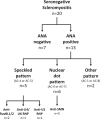Recognising the spectrum of scleromyositis: HEp-2 ANA patterns allow identification of a novel clinical subset with anti-SMN autoantibodies
- PMID: 32892170
- PMCID: PMC7509989
- DOI: 10.1136/rmdopen-2020-001357
Recognising the spectrum of scleromyositis: HEp-2 ANA patterns allow identification of a novel clinical subset with anti-SMN autoantibodies
Abstract
Objective: To describe systemic sclerosis (SSc) with myopathy in patients without classic SSc-specific and SSc-overlap autoantibodies (aAbs), referred to as seronegative scleromyositis.
Methods: Twenty patients with seronegative scleromyositis diagnosed by expert opinion were analysed retrospectively for SSc features at myositis diagnosis and follow-up, and stratified based on HEp-2 nuclear patterns by indirect immunofluorescence (IIF) according to International Consensus of Autoantibody Patterns. Specificities were analysed by protein A-assisted immunoprecipitation. Myopathy was considered an organ involvement of SSc.
Results: SSc sine scleroderma was a frequent presentation (45%) at myositis diagnosis. Myositis was the most common first non-Raynaud manifestation of SSc (55%). Lower oesophagal dysmotility was present in 10 of 11 (91%) investigated patients. At follow-up, 80% of the patients met the American College of Rheumatology/EULAR SSc classification criteria. Two-thirds of patients had a positive HEp-2 IIF nuclear pattern (all with titers ≥1/320), defining three novel scleromyositis subsets. First, antinuclear antibody (ANA)-negative scleromyositis was associated with interstitial lung disease (ILD) and renal crisis. Second, a speckled pattern uncovered multiple rare SSc-specific aAbs. Third, the nuclear dots pattern was associated with aAbs to survival of motor neuron (SMN) complex and a novel scleromyositis subset characteriszed by calcinosis but infrequent ILD and renal crisis.
Conclusions: SSc skin involvement is often absent in early seronegative scleromyositis. ANA positivity, Raynaud phenomenon, SSc-type capillaroscopy and/or lower oesophagal dysmotility may be clues for scleromyositis. Using HEp-2 IIF patterns, three novel clinicoserological subsets of scleromyositis emerged, notably (1) ANA-negative, (2) ANA-positive with a speckled pattern and (3) ANA-positive with nuclear dots and anti-SMN aAbs.
Keywords: Autoimmune Diseases; Polymyositis; Scleroderma; Systemic.
© Author(s) (or their employer(s)) 2020. Re-use permitted under CC BY-NC. No commercial re-use. See rights and permissions. Published by BMJ.
Conflict of interest statement
Competing interests: None declared.
Figures



Similar articles
-
Systemic Sclerosis-Specific Antibodies: Novel and Classical Biomarkers.Clin Rev Allergy Immunol. 2023 Jun;64(3):412-430. doi: 10.1007/s12016-022-08946-w. Epub 2022 Jun 18. Clin Rev Allergy Immunol. 2023. PMID: 35716254 Free PMC article.
-
Autoantibody profiles delineate distinct subsets of scleromyositis.Rheumatology (Oxford). 2022 Mar 2;61(3):1148-1157. doi: 10.1093/rheumatology/keab492. Rheumatology (Oxford). 2022. PMID: 34146090
-
Scleromyositis: A distinct novel entity within the systemic sclerosis and autoimmune myositis spectrum. Implications for care and pathogenesis.Front Immunol. 2023 Jan 26;13:974078. doi: 10.3389/fimmu.2022.974078. eCollection 2022. Front Immunol. 2023. PMID: 36776390 Free PMC article. Review.
-
Clinical features of Japanese systemic sclerosis (SSc) patients negative for SSc-related autoantibodies: A single-center retrospective study.Int J Rheum Dis. 2020 Aug;23(9):1219-1225. doi: 10.1111/1756-185X.13908. Epub 2020 Jul 14. Int J Rheum Dis. 2020. PMID: 32662135
-
Chronic dyspnea with Raynaud's phenomenon and elevated ANA: A diagnosis of systemic sclerosis sine scleroderma.Am J Med Sci. 2023 Feb;365(2):198-204. doi: 10.1016/j.amjms.2022.01.023. Epub 2022 Mar 8. Am J Med Sci. 2023. PMID: 35276077 Review.
Cited by
-
Myopathy in systemic sclerosis.Curr Opin Rheumatol. 2023 Nov 1;35(6):341-348. doi: 10.1097/BOR.0000000000000966. Epub 2023 Aug 22. Curr Opin Rheumatol. 2023. PMID: 37650694 Free PMC article. Review.
-
Understanding the value of non-specific abnormal capillary dilations in presence of Raynaud's phenomenon: a detailed capillaroscopic analysis.RMD Open. 2022 Sep;8(2):e002449. doi: 10.1136/rmdopen-2022-002449. RMD Open. 2022. PMID: 36197673 Free PMC article.
-
Anti-RuvBL1/2 Autoantibodies Detection in a Patient with Overlap Systemic Sclerosis and Polymyositis.Antibodies (Basel). 2023 Feb 3;12(1):13. doi: 10.3390/antib12010013. Antibodies (Basel). 2023. PMID: 36810518 Free PMC article.
-
An update on autoantibodies in the idiopathic inflammatory myopathies.Nat Rev Rheumatol. 2025 Jan;21(1):46-62. doi: 10.1038/s41584-024-01188-4. Epub 2024 Nov 28. Nat Rev Rheumatol. 2025. PMID: 39609638 Review.
-
Anti-U11/U12 Antibodies as a Rare but Important Biomarker in Patients with Systemic Sclerosis: A Narrative Review.Diagnostics (Basel). 2023 Mar 27;13(7):1257. doi: 10.3390/diagnostics13071257. Diagnostics (Basel). 2023. PMID: 37046475 Free PMC article. Review.
References
-
- Parker MJS, Oldroyd A, Roberts ME, et al. The performance of the European League Against Rheumatism/American College of Rheumatology idiopathic inflammatory myopathies classification criteria in an expert-defined 10 year incident cohort. Rheumatology (Oxford) 2019;58:468–75. 10.1093/rheumatology/key343 - DOI - PMC - PubMed
Publication types
MeSH terms
Substances
LinkOut - more resources
Full Text Sources
Medical
Miscellaneous
